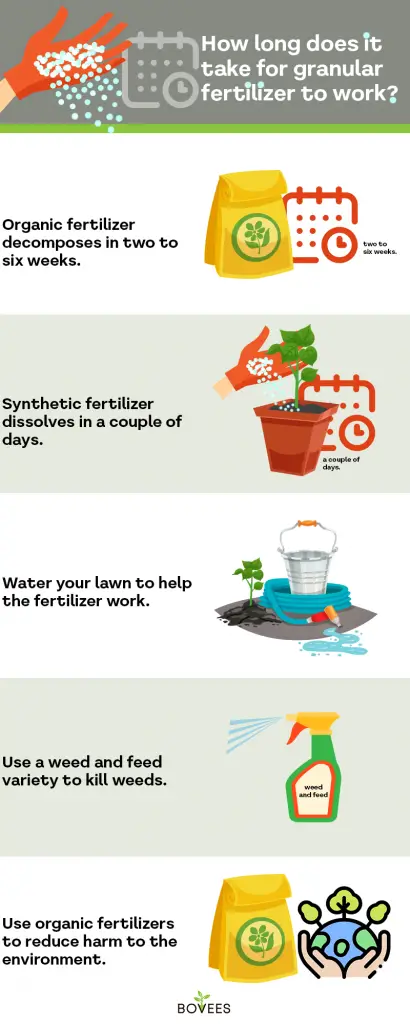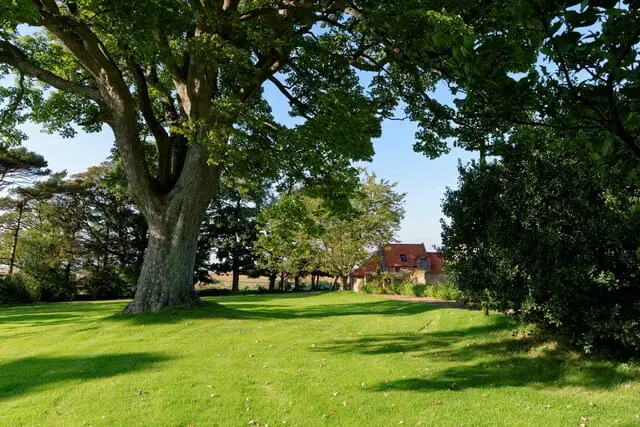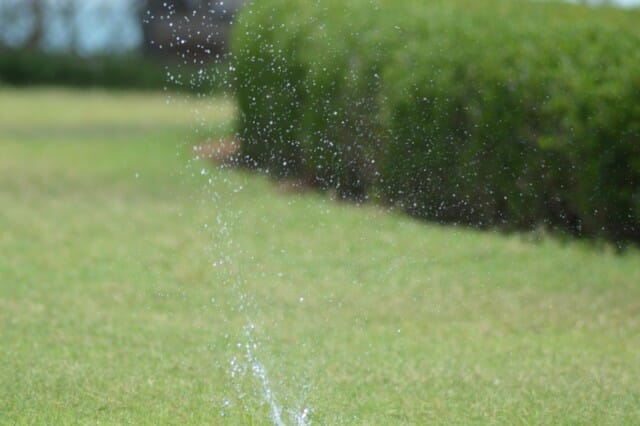Last Updated on May 17, 2022 by Grow with Bovees
You’ve spread your lawn with nitrogen rich fertilizer or turf builder. You’ve taken care to disperse it. Now, you’re probably asking the question, how long does it take for granular fertilizer to dissolve, and when will you see some amazing results of healthy plant growth?
Well, it depends on the type of fertilizer you are using.
If it is a slow releasing product, then it will take much longer than if it was something like quick-acting. But I would say that, in general, it should start to improve plants within about 2 weeks after applying fertilizer.
The Importance of Fertilizing Your Grass

There’s never been a better way to outdo your neighbors than by having a lush green lawn right there at the front of your house. But having a healthy lawn is about much more than just green grass.
If you think of your lawn as a child, you know that new grass seed or an already established lawn will need a nutritious diet to grow, to become strong, and even to fight off infections.
So, as an adoptive parent to your lawn, it’s up to you to choose the right fertilizer that can make this happen, whether it be a water soluble powdered fertilizer, liquid fertilizers or any slow releasing products.
In this article we will put our main focus on organic granular fertilizer products, answering questions such as, how do organic fertilizers work and why you should apply them to your plants.
So How Long Does it Take For Granular Fertilizer to Work?
The question at hand, how long does it take for granular fertilizer to work on your plants or turf, is one commonly asked.
The use of granular fertilizer depends on a couple of things. First, are you using organic slow-releasing or synthetic quick-release fertilizers?
People who are looking for a quick fix for their plants and lawns often choose a fast release synthetic fertilizer as you see the results within a few days.
Organic fertilizers, on the other hand, can take between two to six weeks to show any benefit. So, you’re probably thinking that only a crazy person would choose slow acting and not the quick acting option, but here are a few reasons to think again.
A slow release granular fertilizer will last anywhere between two to nine months after application.
Organic Granular Fertilizer
Why Do Organic Fertilizers Take Longer to Work?
Organic slow-release fertilizers are full of all kinds of good stuff to work effectively on your lawn and soil. They contain the usual nitrogen, phosphorus, and potassium but they also include micronutrients, potash, and microorganisms.
As the name suggests, all these nutrients come from organic sources like bone meal, blood meal and fish emulsion. This may not sound delicious to you, but your grass and soil loves it.
Organic materials are not like chemicals that simply soak into your lawn and soil, unlike quick-releasing lawn fertilizer, they have to decompose. Think about the food scraps you put into your compost box or actually don’t. It’s kind of disgusting, but your lawn is more than happy to get a huge helping of decomposing organic matter.
In cold weather we recommend you use a quick release product as the slow acting formula does not work as well during that time.
Synthetic Granular Fertilizer
What Is in Synthetic Granular Fertilizer?
Almost all fertilizers contain three things: nitrogen, potassium, and phosphorus. The producers of synthetic fertilizers create different ratios of these nutrients artificially in a lab.
Because they are artificial, they can easily be made into a fast acting fertilizer, meaning that your lawn will get an immediate serving of the nutrient contents after application..
These products also tend to have a high nitrogen content because nitrogen is a component of chlorophyll. You may remember chlorophyll from your school science class as the stuff that makes plants green.

What You Can Do
When it comes to choosing your synthetic fast release fertilizer, you can read the label and check for the amount of nutrients it contains. For example, when you apply fertilizer in spring you want to choose a fertilizer that is a little higher in phosphorus to stimulate root growth.
Another thing you can do is use the best weed and feed for your type of lawn. Even though I love animals, I’m one for killing two birds with one stone. This product nails the nutritional needs of your grass blades and slays weeds at the same time.
Popular Synthetic Fertilizer For use on New Lawns and in Spring
Springtime and new grass have one thing in common: they both require a rapid dose of nutrition. Scotts Turf Builder, which comes in a weed and feed variety, is my go-to product when thinking about a spring feeding for an existing lawn or when I’m dealing with a new lawn. Scotts turf builder is fast and powerful and provides a jolt of nutrients that is kind of like a morning coffee for your lawn.
Comparison Between Granular Fertilizers?
The one thing that synthetic fertilizers have over organic is speed. Because they are fast-release fertilizers, you will see results in your grass in just two to five days. However, that’s really all it has over a slow releasing fertilizer.
Organic fertilizer has the added benefits of micronutrients, potash and microorganisms, and, because they are organic, they are not harmful to the environment and require less water.
Why Use Organic Granular Fertilizers?
One thing not to like about synthetic fertilizers is that they create a dependent relationship between your lawn and nitrogen. The grass starts to crave the nitrogen fix like you might crave a cigarette or sugar.
Slow releasing fertilizer, on the other hand, will work to make your lawn independent. If used correctly, organic fertilizers can teach your grass to fight weeds on its own, which means saying goodbye to pesticides and herbicides forever.
When to Use Fertilizer for Best Results?
Knowing what time of day and how often to fertilize your lawn is one of those age-old questions that most people don’t agree on. My simple rule for this has never let me down.
The most common time of year to use lawn fertilizer is early to late spring or early to late fall.
If the forecast calls for a scorcher, then I would fertilize in the afternoon. If it’s going to be a cool day, I opt for the morning.
Another thing to keep in mind is the amount of sun expected on fertilizing day. Just like with people, your grass can burn in direct sun. It’s best to put off fertilizing until you see clouds in the forecast. Be careful that the prediction does not come with heavy rain.
Always mow your lawn before you decide to fertilize. Mowing not only exposes the soil, which is where you want the fertilizer to end up, but it also removes excess lawn waste, which helps the fertilizer to soak into the soil and work more efficiently.
How Often to Apply Granular Fertilizer
If you are using a slow release granular fertilizers, and you want a green lawn, you should fertilize four times a year.
A general rule of thumb is to apply fertilizer in late and early spring and then again in late and early fall. Summer is generally too hot.
With slow-releasing fertilizer, you should water your lawn a day or two before applying to get it ready to decompose, wait until the wet grass dries and apply then fertilize. If there is no heavy rainfall in the forecast, you need to lightly water your lawn a few days after you apply fertilizer.
Do not apply a fertilizer to soaking wet grass or during times of heavy rain, this may cause the particles to stick to the grass blades which could cause them to become damaged.

The synthetic variety needs to be applied more often to maintain green grass and, most importantly, you need to avoid foot traffic keeping children and pets off of the grass for 24 hours after applying.
You don’t want Fido or your precious toddler to get a mouthful of grass that has been sprinkled with chemicals.
How Long Does Slow Release Fertilizer Last in Soil?
Organic slow release products take two weeks or more to decompose into the soil. Maybe a better question to ask is how long does it last in the soil?
An organic, granular fertilizer may provide nutrients to your lawn for anywhere from three months to 10 years after application. Now that’s a lot of green for your buck. Scotts and Pennington are two major players in the lawn care product market that you may want to consider.
Why Not Liquid Fertilizer?
While the content of nutrients between the two forms of fertilizer can be the same, liquid fertilizer has shown to be quite hard to spread equally across the yard. It is therefore mainly used by professionals. Liquid fertilizer takes about 24hrs to work, which makes it faster than other products as liquid seeps fast into the soil, revealing healthy plants and grass in under two weeks..
Unless you own an easy liquid fertilizer sprayer, we suggest that you stick to any granular organic fertilizer.
Does Fertilizer Go Bad?
So, now that you’re ready to fertilize, maybe you’re wondering about that old bag of fertilizer at the back of your shed?
How long is that fertilizer good for? Fortunately, the nutrients in fertilizer don’t break down if they are kept dry. Even if humidity has caused the fertilizer to clump, simply break any lumps you find with a hammer and you are good to go.
To Sum Up

There are definite advantages and disadvantages to both organic slow releasing and synthetic fast release lawn fertilizers.
What you choose to fertilize your lawn is up to you. If speed is of the essence and you want a quick boost of new growth, pick synthetic fertilizer. It dissolves quickly, so you’ll see results in a day or two.
If you are in it for the long haul and want to create a lawn that is more self-sufficient and has less of an environmental impact, I strongly suggest going with an environmentally friendly organic slow-releasing lawn fertilizer. It takes a little more time to decompose, but it’s worth it.

